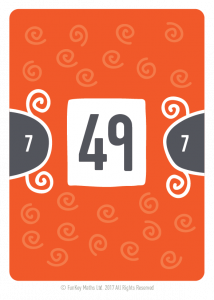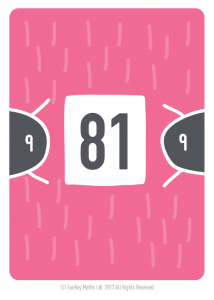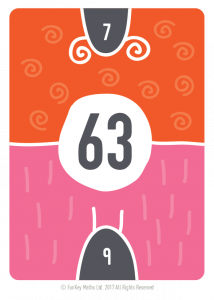Productive ways to prepare for the MTC!
I’m not a fan of the MTC and would prefer it if our 8- and 9-year-olds were encouraged to explore multiplicative connections in more productive ways, without the pressure of a timed, computerized, summative test.
I’ve already written about the permissible access arrangements which can ease the burden of the test for pupils who are either struggling with anxiety or unable to input answers quickly enough. Please do read this and use the arrangements to the full.
This blog seeks to help teachers and their students prepare for the MTC by suggesting a way to use the time left between now and the MTC in a productive way.
Which facts to focus on?
If you read the small print in the Department of Education’s guidance, MTC Assessment Framework it is clear that the fifteen most likely questions to crop up are these:
| 6 x 6 | ||||
| 6 x 7 | 7 x 7 | |||
| 6 x 8 | 7 x 8 | 8 x 8 | ||
| 6 x 9 | 7 x 9 | 8 x 9 | 9 x 9 | |
| 6 x 12 | 7 x 12 | 8 x 12 | 9 x 12 | 12 x 12 |
Predictably, this list of questions includes many of the facts which are hardest to remember if you are relying on digging out answers which “sound” right. When it comes to retrieving an answer from verbal memory, all of us are subject to memory lapses, and what is called “pattern interference”.
Pattern interference
Nine sevens? Is it 63 or 64?
64 sounds very plausible to verbal memory – it’s only the final syllable which is wrong, and being the final syllable, it gets lost as the voice falls. It would be very easy to fall prey to pattern interference on this question if you were relying solely on verbal memory. There is limited value to trying to brute force answers into children’s verbal memory in the remaining weeks before the test. Pattern interference will likely run riot and once the test is over the memories will fade quickly.
Making connections between products
A much more effective approach, in the short and the long term, is to focus time and effort on composing and decomposing the products which are the answers to these 15 tricky questions.
The questions relate to 14 products:
36, 42, 48, 49, 54, 56, 63, 64, 72, 81, 84, 96, 108, 144
What if we spent time exploring these products and discovering how we could build them up from other facts already known. In the first grid below, the facts in the first row are all from the 2x or 3x tables. Assuming these facts are known, they simply need to be doubled and you have nailed the answers to five of the 15 tricky questions.
| 18 – 3 x 6 | 21 – 3 x 7 | 24 – 3 x 8 | 27 – 3 x 9 | 36 – 3 x 12 |
| 36 – 6 x 6 | 42 – 6 x 7 | 48 – 6 x 8 | 54 – 6 x 9 | 72 – 6 x 12 |
Double these again and you have nailed another four of the tricky questions (and a second way to link 6, 12 and 72).
| 36 – 6 x 6 | 42 – 6 x 7 | 48 – 6 x 8 | 54 – 6 x 9 | 72 – 6 x 12 |
| 72 – 12 x 6 | 84 – 12 x 7 | 96 – 12 x 8 | 108 – 12 x 9 | 144 – 12 x 12 |
There are three other doubles which could be practised.
8 x 7 can be derived from 4 x 7 and 2 x 7
8 x 8 can be derived from 4 x 8 and 2 x 8
8 x 9 can be derived from 4 x 9 and 2 x 9
Square numbers
That leaves just 3 tricky facts. Two of these are square numbers. The sound bites for 7 x 7 and 9 x 9 are reasonably rhythmical and worth rehearsing. If you have the FunKey Times Tables cards, the colours and shapes on the cards can also really help reinforce recall of the factors of 49 and 81.


(If you haven’t got FunKey cards yet, buy an intervention set here – 6 packs for £50. Teachers across the country have seen the FunKey times tables cards make a huge difference to children who don’t respond well to traditional chanting techniques.)
The final fact
There is just one fact left: 7 x 9.
Is it 63 or 64?
If you have spent time on concept and structure and connections children will know that it can’t be 64. Why not? Easy!
Odd factor x Odd factor = Odd product.
Link 7 x 9 to 7 x 3 and practise adding 21 + 21 + 21 = 63. Show that 9 x 7 is the same as 10 x 7 – 7. GIve children time to rehearse that calculation so that it becomes familiar,
 Show children the FunKey Times Table card for 63 and discuss who likes the colour combination of orange and pink (I do not!). For some children, the colour coding will be enough to build a strong association between 7, 9 and 63.
Show children the FunKey Times Table card for 63 and discuss who likes the colour combination of orange and pink (I do not!). For some children, the colour coding will be enough to build a strong association between 7, 9 and 63.
All of these discussions will help build alternative routes to the correct answer. Each child only needs one reliable route for each fact, but having more than one route will help secure the fact and build longer term fluency.
Invest time for the future!
So, as you consider how to prepare for the MTC, be strategic about which facts you focus on. Focus time now on really nailing the trickiest 15 questions. In doing so, you will be investing in long-term wins for children. Mindlessly chanting disconnected facts is not the way forward at this, or at any, stage.
